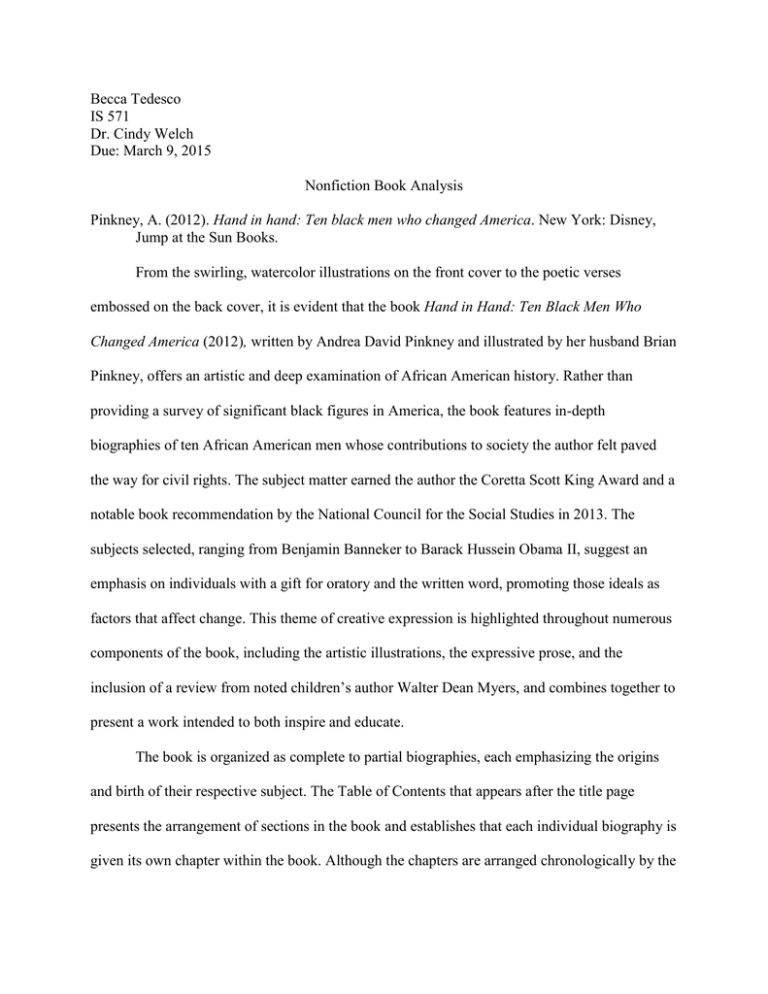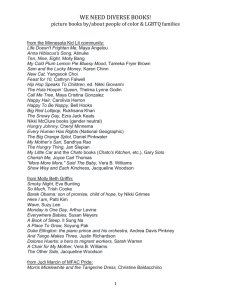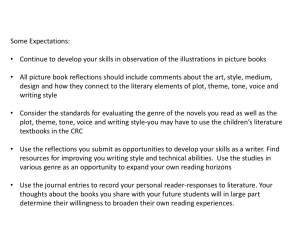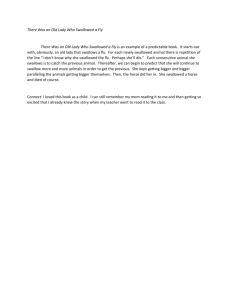Becca Tedesco IS 571 Dr. Cindy Welch Due: March 9, 2015
advertisement

Becca Tedesco IS 571 Dr. Cindy Welch Due: March 9, 2015 Nonfiction Book Analysis Pinkney, A. (2012). Hand in hand: Ten black men who changed America. New York: Disney, Jump at the Sun Books. From the swirling, watercolor illustrations on the front cover to the poetic verses embossed on the back cover, it is evident that the book Hand in Hand: Ten Black Men Who Changed America (2012), written by Andrea David Pinkney and illustrated by her husband Brian Pinkney, offers an artistic and deep examination of African American history. Rather than providing a survey of significant black figures in America, the book features in-depth biographies of ten African American men whose contributions to society the author felt paved the way for civil rights. The subject matter earned the author the Coretta Scott King Award and a notable book recommendation by the National Council for the Social Studies in 2013. The subjects selected, ranging from Benjamin Banneker to Barack Hussein Obama II, suggest an emphasis on individuals with a gift for oratory and the written word, promoting those ideals as factors that affect change. This theme of creative expression is highlighted throughout numerous components of the book, including the artistic illustrations, the expressive prose, and the inclusion of a review from noted children’s author Walter Dean Myers, and combines together to present a work intended to both inspire and educate. The book is organized as complete to partial biographies, each emphasizing the origins and birth of their respective subject. The Table of Contents that appears after the title page presents the arrangement of sections in the book and establishes that each individual biography is given its own chapter within the book. Although the chapters are arranged chronologically by the Tedesco 2 birth of each individual, that is not immediately evident from the Table of Contents, which, in chart format, provides the name of the person, a meaningful epithet, and the page number the chapter begins on, but does not include any biographical information such as birthdates. The author’s choice to use this organizational format suggests that the book is intended to focus on each individual figure rather than provide an overarching view of the history of civil rights. As common with nonfiction works, a reader can examine this text out of order or only focus on one chapter of particular interest, suggesting that it could be a useful source for a research paper or a pleasant coffee table book or item in a personal library for browsing. A timeline and index are provided in the back of the book, allowing for readers to visualize the moments when some of the featured men’s lives overlap or to search for specific terms. The stories of these men are ones that have the potential to interest most readers, however, the diction, writing style, and emphasis on text incorporated throughout the book is most suited to readers ages nine to twelve. Although the book is accessible to readers of any sex or race, its subject matter is particularly relevant to African American boys ages nine and above, as the author herself explains in the preface when she identifies the “hunger” that such boys have for positive role models (pg. 3). What is unique about the content of this book is the rich details and the focus on the early stages of each individual’s life. While most Americans have a general knowledge of the contributions of Martin Luther King, Jr., not everyone knows that his dedication to reading from an early age aided him in skipping two grades in school, allowing him to start considering colleges at age 14 (pg. 181). These details are important to the audience of the book because they promote the idea that passion, conviction, and dedication to change can start from a young age. The biographies also highlight the failures as well as the successes of the individuals, Tedesco 3 emphasizing each figure’s commitment and determination, an important aspect when considering that the intention of this book is to inspire readers. True to the verbal skills of the individuals she is writing about, Pinkney writes with expression and eloquence, often approaching the biographical content with a poetic license that edges on dramatic, but that parallels the book’s overall artistic feel. One such example is found in Benjamin Banneker’s chapter, which begins, “Benjamin Banneker was born under a lucky star” and later, when describing his father, Robert, states that he “gave freedom a hello hug (pg. 9).” The emphasis on creative expression is made clear from the numerous poems that are scattered throughout the book. A poem is found immediately after the Table of Contents, at the beginning of each chapter, and random prose are incorporated into the biographical text, such as at the conclusion of Frederick Douglass’ chapter, which states, “He was a lion-tree of a man./A colored king./The capital orator./Frederick Augustus Douglas. (pg. 39)” Pinkney’s lyrical style draws attention to the fact that she is foremost an award-winning author rather than an African Studies scholar, however, the extensive details in the book and the inclusion of a Sources and Further Reading section suggest that the content was thoroughly researched. In keeping with the overarching theme of the book, the author does not sanitize or dilute themes of social and civic injustices encountered throughout the men’s lifetimes. Instead, they are presented as challenges that each man sought to overcome. The mixed attitudes toward Booker T. Washington’s teaching philosophies are openly described, as is the awareness of the danger that each individual faced, such as the fact that, if caught during his escape to freedom, Frederick Douglas would be killed (pg. 30-1). Although the expressive writing of Pinkney adds character and approachability to each of the subjects, it also brings in to question whether some of the descriptions are accurately Tedesco 4 interpreted from source material or whether they are insinuations from the author’s imagination. For example, in describing a gift that W.E.B. DuBois received from a local bookstore owner, she claims, “Mr. Morgan could see that W.E.B. was destined for great things,” but provides no citation or quotation to suggest whether this statement is based on a document or simply inferred by her. In fact, although occasional quotations are scattered throughout the book, no in-text citations are used, leaving the reader at a loss if interested in knowing which source a particular piece of information stemmed from. This would be particularly frustrating to someone using the book to write a research paper. Despite the inclusion of a Sources/Further Reading section, no distinction is made to differentiate whether an item on the list was used as a reference piece in the book or whether it is included as suggested reading to learn more about the subjects. Another issue prevalent throughout the book is the lack of speeches, writing samples, and quotations by the figures represented in the text, especially when considering that these men are being highlighted for their exceptional words of persuasion. Although the poems featured at the beginning of each chapter match the overall style of the book and provide Pinkney’s lyrical summary of each individual’s contributions, a sample of writing or part of a speech from the individual would be more insightful and authoritative for a nonfiction work. A similar issue is found in the dynamic illustrations presented throughout the book. While the vibrant blending of lines and colors parallel the expressive and creative nature of the book, they are an artist’s interpretation of individuals. Incorporating actual photographs or less abstract drawings in place of the spot illustrations integrated throughout the book as well as clear captions would have added accuracy to the book’s content. Overall, Pinkney has delivered a moving tribute to ten great African American men who left indelible marks on the fabric of the United States of America. While the book is decisively Tedesco 5 didactic in nature, it is also serves to inspire readers and present positive portrayals of black men at a time when racial stereotyping is still frequent. The author presents this book with a strong message, claiming, “It is my hope that the qualities embodied in the stories of each Hand in Hand man will encourage young readers to build connections that will link them to their birthright of excellence (pg. 4).” The idea behind this book has the potential to continue onward, as there are countless other lesser known black men and women who impacted life in America and have moving stories that young ears long to hear. For a stirring foundation, Hand in Hand: Ten Black Men Who Changed America, provides an insightful and ebullient approach to individuals who fought for equality in America.



